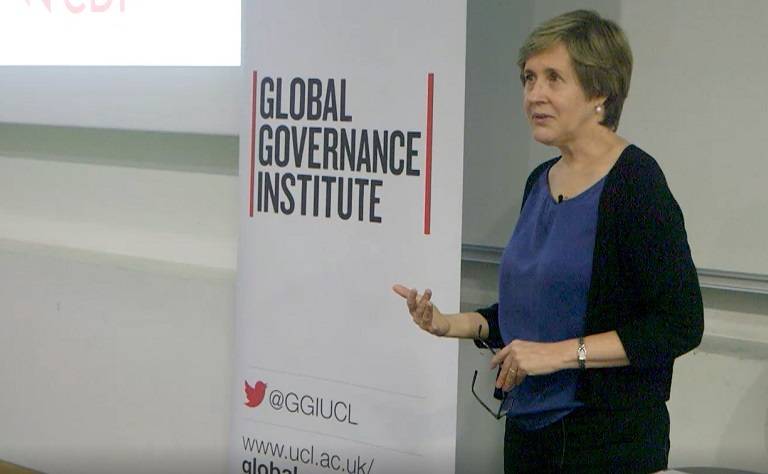The Promise and Pitfalls of Collaborative Governance
27 November 2017
Giulia Ragosa (MSc Global Governance and Ethics) on a GGI keynote lecture with Professor Ann Florini.

Global governance is getting increasingly bold. A number of new initiatives call for the private sector to take responsibility for tackling global problems, challenging the traditional idea of social contract - in which governmental actors are the main players in ensuring the wellbeing of our society. Agreements such as the 2015 Sustainable Development Goals (SDGs) and the 2015 Paris Agreement signify an ongoing shift towards multi-stakeholder collaboration, by offering guidance and a common platform for governments, businesses and civil society to tackle the most compelling global public policy issues of our time.
However, the extent to which this is wishful thinking rather than a practical way forward remains to be seen. In fact, there are consistent challenges in getting businesses to do their homework. At a recent Global Governance Institute (GGI) event, Ann Florini, Professor of Public Policy at Singapore Management University, discussed the perks and flaws of this experimental approach to global governance.
The jet engine and the garden
Collaborative governance, partnerships, networks, multi-stakeholder collaboration: terms like these are quite popular these days, but their meanings are sometimes difficult to pin down. John Elkington has compared the idea of collaborative governance to the invention of the jet engine: its success relied on a combination of previously existing technologies - a compressor, a combustion chamber and a turbine. Collaborative governance is built on a similar idea: combining existing pieces - government, business and civil society - in a completely new way.
However, Florini argued that this mechanistic vision can be misleading, as the workings of human society are fluid and less predictable as those of machines. She suggested an alternative metaphor, namely that of a shared garden. In order to make our garden prosper we have to make some important decisions: artificial or organic fertilizer? What crops to grow? Only experimentation can provide the desired answers. Similarly, the proponents of collaborative governance are trying to work out how exactly to enact their shared vision, by conducting some successful and some not-so-successful experiments.
Mission Zero
To illustrate the potential merits of collaborative governance, Florini shared the story of an unusual yet extremely prolific partnership. Several hundred thousand tons of nylon fishing nets are discarded in the oceans every year, causing serious environmental consequences. In 1994, Interface, a US-based modular carpet company, decided to go green by embarking on 'Mission Zero', a business plan with the goal of producing zero externalities. In collaboration with the Zoological Society of London and a recycling company, it set up a successful system to recycle the discarded nylon nets. Local coastal communities in Southeast Asia have been put in charge of collecting the nets, leading to financial inclusion and poverty alleviation in these areas. In this equation, profit, sustainability and development seem to coexist, with a perfect alignment of interests.
This initiative, like others, shows that collaborative partnerships can produce inspiring outcomes. This is supported by a shift in narratives in international forums, which are developing more systematic approaches to engage non-state actors. For example, the SDGs offer a detailed framework with precise guidelines for business behaviour. In Florini's own words: "Businesses sometimes do not understand the language of sustainability and development, but they understand targets and deadlines very well."
Not all that glitters is gold
Despite some achievements and the growing enthusiasm for cross-sector collaboration, we are far from where we should be. First, there is the problem of efficacy: it is still not clear how well and under what conditions these partnerships work. They are extremely difficult to monitor and they can easily result in exploitation of locals, who have less leverage on the terms of the collaboration. Also, far too often, corporations cherry-pick SDGs with the sole purpose of not getting caught in the spotlight.
Second, conciliating sustainability with the profit-driven philosophy of today's businesses might prove harder than predicted. Corporations love to externalize costs, so why should they throw their money away in the pursuit of the wellbeing of global society? The answer lays in what Florini calls the 'push and the pull' factors. Social pressures and non-financial reporting 'push' companies to comply with codes of conduct and standards laid out by transnational bodies. On the 'pull' side, sustainable development might also turn out to be good for companies' pockets: the Business and Sustainable Development Commission has identified USD 12 trillion profit opportunities in the SDGs.
However, even if cross-sector partnerships are effective as well as profitable, they often lack legitimacy, posing serious challenges for democracy. In a world where power asymmetries are skewed towards who is in control of capital, these issues go too often unaddressed.
So how do we do it?
Despite these potential pitfalls, Florini suggested that solutions exist. First on her list is something academics are extremely familiar with: peer-review. If properly systematized, she argued that this could be an effective way to keep corporations under check. However, other than bringing up some examples of academics currently engaged in monitoring activities, she remained very vague about who should take on this arduous task.
Florini made another very compelling call to action for academic institutions. Far too often, she pointed out, students in business schools are taught how to avoid taxes and regulations, rather than to show sensitivity towards the welfare of our planet. A shift in mentality within universities towards cross-sector collaboration is a strong way forward in creating entrepreneurs with a conscience and policymakers able to create and manage partnerships. While this would definitely represent a radical improvement, I am afraid that its positive effects could be felt too late.
The Fourth Sector
Lastly, Florini brought us back in history. She explained that before the late 19th century corporations used to be established by states for specific public purposes. Why, then, have we decided to passively assent to the creation of a completely separate, purely financially driven sector with no responsibilities? Even at present times, the Western publicly traded corporation is not the only business model available. Asian companies, for example, differ greatly from this paradigm - although too little attention is being paid to them. Thus, both history and the present provide us with alternatives to the current neoliberal manifestation of capitalism.
Florini is calling for a radical transformation of our economy's DNA, which would incorporate profit mechanisms as well as sustainable governance and civil society engagement. By pushing private businesses in the neutral area that lays between for-profit and non-profit, she argued, we might bring about a 'Fourth Sector', comprised of profitable social enterprises.
The expedition upon which Florini is asking us to embark does not lack ambition and its success depends greatly on our ability to convert an inspirational discourse into something more real. As we have learnt, some bold policy entrepreneurs are already making giant leaps forward in unknown territories. For now, these remain widely unexplored, but there is hope that the adventurous nature of men that took us all the way to the moon, will also be able to drive us through the challenges we are facing in saving our own planet.
 Close
Close


